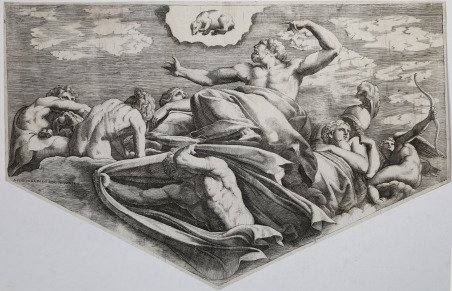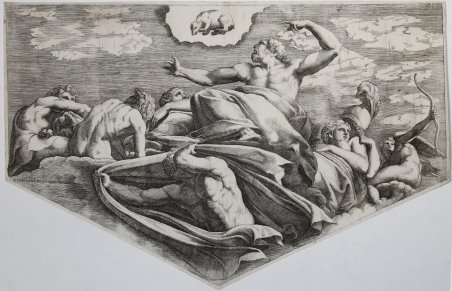Bulino, 1541-1544 circa, iscritta in basso a sinistra 'A.FONTANA.BLEO.BOL INVENTOR'. Esemplare nel suo secondo stato finale, con l’iscrizione aggiunta, secondo Boorsch, Lewis e Lewis. L'iscrizione A-FONTANA BLEO BOL INVENTOR indica che l'incisione riproduce un'opera di Primaticcio per Fontainebleau. H. Zerner ha associato la composizione alla decorazione dell'Appartement des Bains. Reiset, invece, riteneva che la composizione fosse stata dipinta ad affresco sul soffitto della Galerie d'Ulisse, ma già Dimier faceva notare che nessun tema simile vi era mai apparso. La composizione è nota anche in un disegno delle stesse dimensioni ma in senso inverso, ora al Louvre, Parigi (INV. 8536). Il foglio mostra una composizione iscritta in una forma pentagonale irregolare che potrebbe, secondo Ch. Eschenfelder, essere la metà di un esagono regolare, seguendo un tipo di partizione nota per le lunette dell'Appartement des Bains. ' Secondo Boorsch (The French Renaissance in Prints, pp. 337-339, n. 93) il tema iconografico è la storia di Giove e Callisto, raccontata nelle Metamorfosi di Ovidio (2,409-530): la scena rappresentata, dipinta in una volta, era il culmine della storia: "Ma Giove tenne la sua mano [di Arcas] e salvò entrambi, la madre dalla morte e il figlio dal crimine. Poi, prendendoli per aria in un turbine, li pose nei cieli e li fece diventare stelle vicine" (Metamorfosi 2.505-7). Se l'ipotesi formulata da S. Boorsch è corretta, l'inserimento de La caduta di Fetonte (Zerner 6) nello stesso luogo potrebbe essere un'idea plausibile: le due scene costituirebbero allora rispettivamente la premessa e l'epilogo della Storia di Callisto, in una sorta di contrappunto. Infatti, in entrambe le composizioni, Giove è l'eroe rispettivamente di una caduta e di una risalita al cielo. Detto questo, non sembra che le dimensioni delle due scene siano omogenee. L'incisione di Giove e Callisto (conosciuta anche come Giove e altri dei che guardano Callisto) è stata attribuita a diversi autori: Huber e Le Blanc, interpretando male il testo del Vasari, hanno attribuito l'esecuzione a Luca Penni; Mariette, seguito dalla critica, ha esitato tra Giorgio Ghisi e Guido Ruggieri. Bartsch l'ha attribuita a Giorgio Ghisi. Oggi, l’opera tende ad essere incluso nel corpus del Maestro FG. Stefania Massari ha mantenuto l'attribuzione a Ghisi, credendo che quella di "FG" fosse un’altra stampa. Boorsch, Michal e R. E. Lewis, sulla base di affinità stilistica, suggeriscono che l’incisione possa rientrare nel corpus di opere di Girolamo Fagiuoli che potrebbe, forse, celarsi dietro il monogramma FG. Secondo C. Jenkins, non ci sono evidenze per identificare con certezza l’incisore che si cela dietro le lettere FG. Questo misterioso incisore, che firmava la maggior parte delle sue opere con le lettere F e G sovrapposte, produsse sette meticolose incisioni da un gruppo di disegni per Fontainebleau, datate tra il 1541 e il 1544.334 Tutti gli esemplari sopravvissuti delle sue stampe sono su carta italiana, il che suggerisce che fosse attivo in Italia. Sei delle sette incisioni conservano la direzione originale delle composizioni di Primaticcio (solo Giove e Callisto è in controparte), e cinque sono iscritte A FONTANA BLEO BOL. Questa stessa scritta si trova su due stampe di Giorgio Ghisi e Domenico del Barbiere, il che suggerisce che Primaticcio abbia richiesto questa particolare dicitura. Bellissima prova, impressa su carta vergata coeva con filigrana “testa umana nel cerchio”, rifilata al rame, in ottimo stato di conservazione. Rara. Bibliografia Bartsch, XV, 59; TIB, XXXI, n. 59 (407); Bellini, Ghisi, p. 304 n. F24; Boorsch, in The French Renaissance in Prints, n. 93, pp. 337-339; Boorsch, M. & R. Lewis, Giorgio Ghisi, p. 212 n. R7; Hind, III, p. 29 n. 2; Zerner, 1990, p. 109 note 1; Massari, p. 157, Incisori mantovani p. 157 n. 229; Primatice, pp. 195-198, n. 73. ' ' Engraving, 1541-1544 circa, inscribed at lower left 'A.FONTANA.BLEO.BOL INVENTOR'. The inscription A. FONTANA BLEO BOL INVENTOR indicates that the engraving reproduces a work by Primaticcio for Fontainebleau. H. Zerner associated the composition with the decoration of the Appartement des Bains. Reiset believed that the composition had been painted in fresco on the ceiling of the Galerie d'Ulysse, but Dimier already pointed out that no such theme had ever appeared there. Example in its second final state, according to Boorsch, Lewis and Lewis (first state before the inscription) The composition is also known in a drawing of the same size but in reverse direction, now in the Louvre, Paris (INV. 8536). The sheet shows a composition inscribed in an irregular pentagonal shape which could, according to Ch. Eschenfelder, behalf of a regular hexagon, following a type of partition noted for the lunettes of the Appartement des Bains. ' According to Boorsch (The French Renaissance in Prints, pp. 337-339, n. 93) the iconographic theme is the story of Jupiter and Callisto, as told in Ovid’s Metamorphoses (2,409-530): the scene shown,painted in a vault, was the culmination of the story: “But Jove held his [Arcas's] hand and rescued both, the mother from death and the son from crime. Then, snatching them up through the air in a whirlwind, he set them in the heavens and made them neighboring stars" (Metamorphoses 2.505-7). If the hypothesis formulated by S. Boorsch is correct, the insertion of The Fall of Phaeton (Zerner 6) in the same place could be a plausible idea: the two scenes would then constitute respectively the premise and the epilogue of the History of Callisto, in a sort of counterpoint. In fact, in both compositions, Jupiter is the hero of a fall and a rise to heaven respectively. That said, it does not seem that the dimensions of the two scenes are homogeneous. The engraving of Jupiter and Callisto (also known as Jupiter and Other Gods Looking at Callisto) it has been attributed to different authors: Huber and Le Blanc, misinterpreting Vasari's text, have attributed the execution to Luca Penni; Mariette, followed by the critics, hesitated between Giorgio Ghisi and Guido Ruggieri. Bartsch, attributed it to Giorgio Ghisi. Today, it tends to be included in the corpus of the FG Master. Stefania Massari kept the attribution to Ghisi, apparently believing there was a second, that one by “FG”. Boorsch, Michal and R. E. Lewis, based on its similarity in style, attribute the work to Girolamo Fagiuoli, identifying the monogram FG as the artist’s name. C. Jenkins writes: “This mysterious printmaker, who signed most of his works with the letters F and G superimposed, produced seven meticulous engravings after a group of designs for Fontainebleau that date between 1541 and 1544.334 Much has been written about the possible identity of the engraver, though no concrete evidence has been found. All the surviving impressions of his prints are on Italian paper, which suggests that he was active in Italy and that Primaticcio wings made their way to him.” (Prints at the Court of Fontainebleau, I, p 62). A fine impression, printed on contemporary laid paper with “human head in the circle” watermark, trimmed to the platemark, very good condition. Rare. Bibliografia Bartsch, XV, 59; TIB, XXXI, n. 59 (407); Bellini, Ghisi, p. 304 n. F24; Boorsch, in The French Renaissance in Prints, n. 93, pp. 337-339; Boorsch, M. & R. Lewis, Giorgio Ghisi, p. 212 n. R7; Hind, III, p. 29 n. 2; Zerner, 1990, p. 109 note 1; Massari, p. 157, Incisori mantovani p. 157 n. 229; Primatice, pp. 195-198, n. 73. Cfr.


Descubre cómo utilizar
Descubre cómo utilizar

